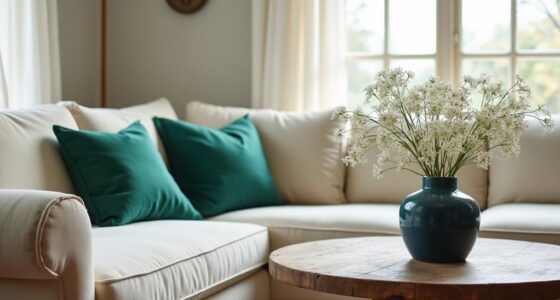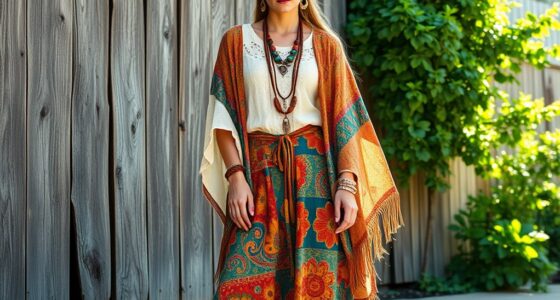Color psychology is key to crafting your perfect home because it directly influences your mood and overall sense of peace. For instance, calming blues and greens can create a serene atmosphere, while warm reds and oranges energize your living spaces. Selecting colors that resonate with your emotions helps you design each room purposefully, from relaxation in the bedroom to productivity in your home office. By strategically using color schemes, you can enhance the visual appeal and emotional response of your environment. You'll find out how to blend these insights into your home for an optimal living experience.
Key Takeaways
- Color psychology significantly influences mood, helping you create a home environment that promotes happiness and relaxation.
- Choosing the right colors for each room enhances its purpose, like calming blues in bedrooms and energizing reds in living areas.
- Understanding emotional responses to colors supports mental well-being, allowing you to design spaces that reduce stress and boost creativity.
- Effective color schemes, whether monochromatic or complementary, enhance visual appeal and create a cohesive atmosphere in your home.
- Natural light affects how colors are perceived, making it essential to consider it when selecting shades for your perfect home.
Understanding Color Psychology
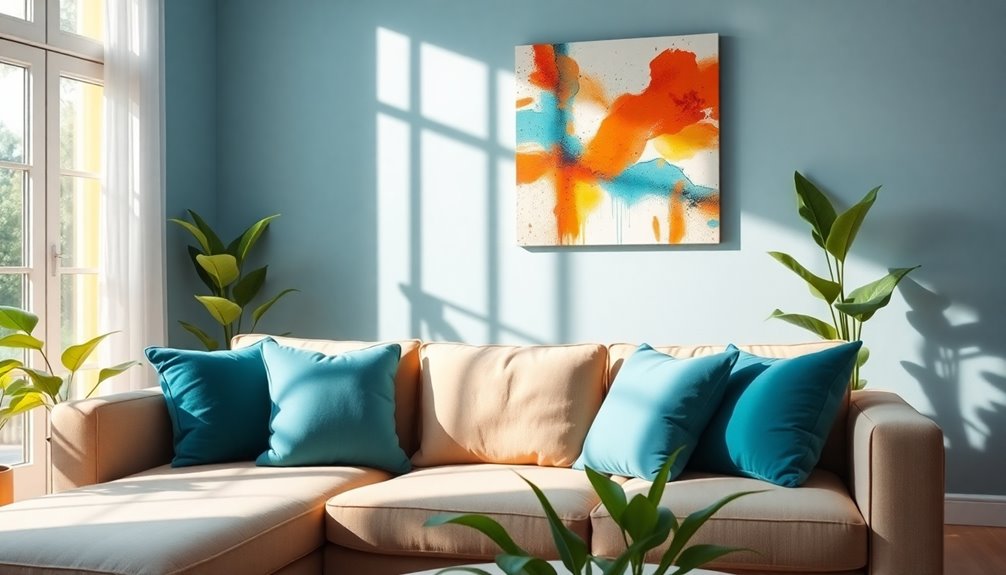
When you think about how colors affect your mood and environment, it's clear that color psychology plays a significant role in our daily lives.
You may not realize it, but colors like green and blue often evoke feelings of nature and calmness, while others like red and orange can energize and stimulate.
Different cultures bring unique meanings to colors; for instance, white symbolizes purity in the West but mourning in many Asian countries.
Historically, colors have also carried significance—red represented power in ancient China.
In art, colors convey emotions and ideas, impacting your perception.
Emotional Responses to Colors

Colors not only shape your environment but also trigger specific emotional responses that can influence your daily life.
For instance, red can ignite your passion and energy, increasing your heart rate and stimulating your senses. Blue, on the other hand, promotes calmness and trust, helping you relax and reduce stress.
Green connects you with nature, enhancing feelings of growth and harmony while improving your vision. Yellow often brings happiness and optimism, boosting your mood and memory.
Lastly, purple inspires creativity and imagination, adding a touch of luxury to your space.
Understanding these emotional impacts allows you to harness colors effectively, creating a home that resonates with your feelings and enhances your daily experiences.
Selecting Colors for Spaces
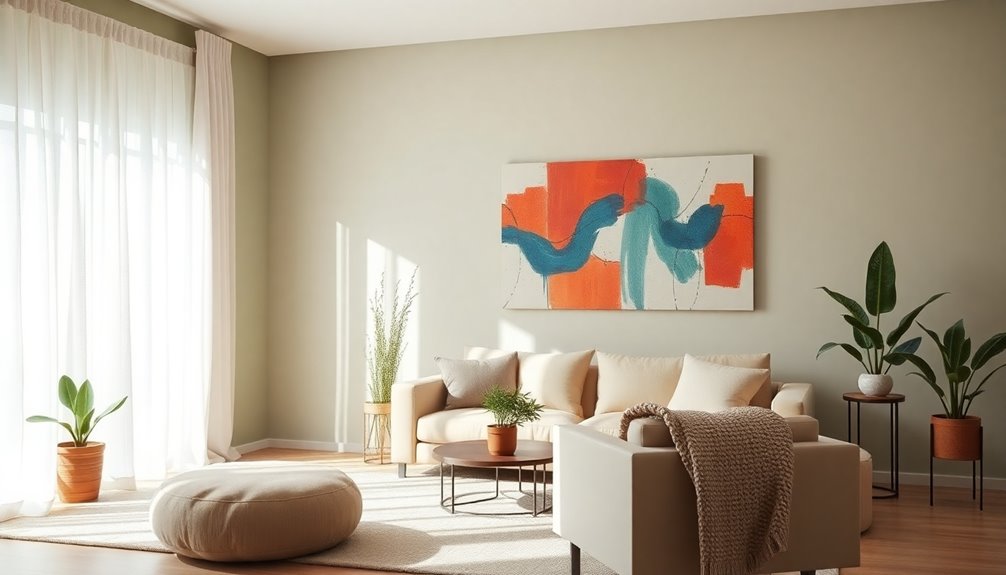
Selecting the right colors for your spaces can transform the atmosphere and functionality of your home.
Warm colors like red and orange can energize your living room, fostering social interaction, while cool colors such as light blue or lavender in the bedroom help you relax and promote sleep.
For your kitchen, consider bright colors like citrus yellow to enhance freshness, and opt for neutral shades like charcoal gray in your office to boost productivity.
Don't forget about natural light; it can change how colors appear throughout the day.
Lastly, balance color intensity with shades of the same color or complementary hues to create visual interest without overwhelming the senses. Incorporating aesthetic hooks and wall organization can further enhance the design by utilizing vertical space effectively.
Choose wisely, and watch your home come alive!
Color Schemes in Design
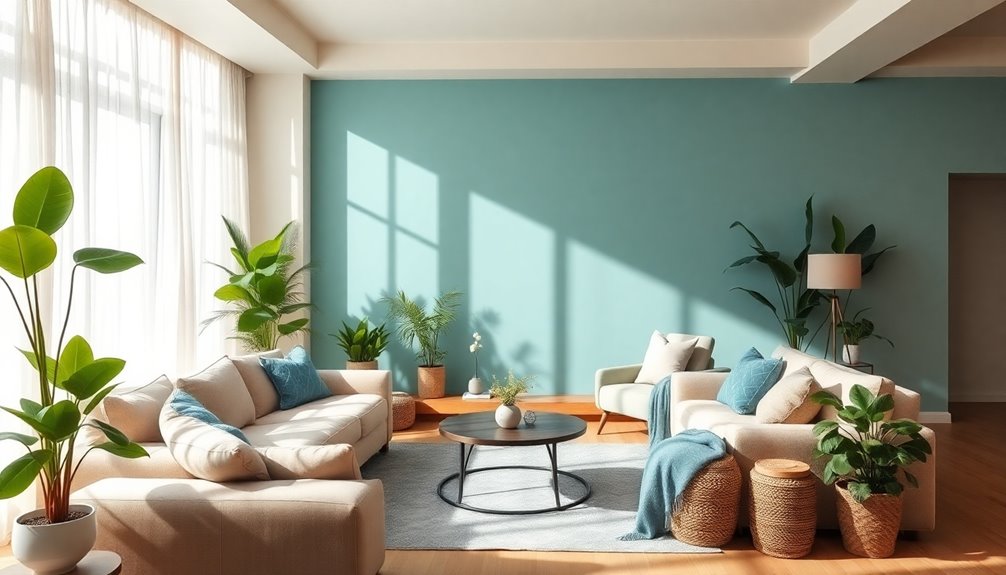
Understanding color schemes is essential for creating a harmonious and visually appealing home. You can choose from several options to achieve the look you want.
Monochromatic schemes use different shades of a single color for a cohesive feel. Complementary schemes create striking contrasts by pairing opposite colors on the wheel, adding energy to your space.
Analogous schemes, which involve colors next to each other, provide smooth transitions and a calming atmosphere. For a balanced approach, consider split-complementary or triadic schemes, mixing colors for visual interest.
Incorporating unique decor styles can further enhance the impact of your chosen color scheme by adding depth and character to your space.
Whichever scheme you choose, ensure it reflects your style while maintaining consistency throughout your home. This attention to detail will elevate your living space and make it uniquely yours.
Effects on Mental Well-being
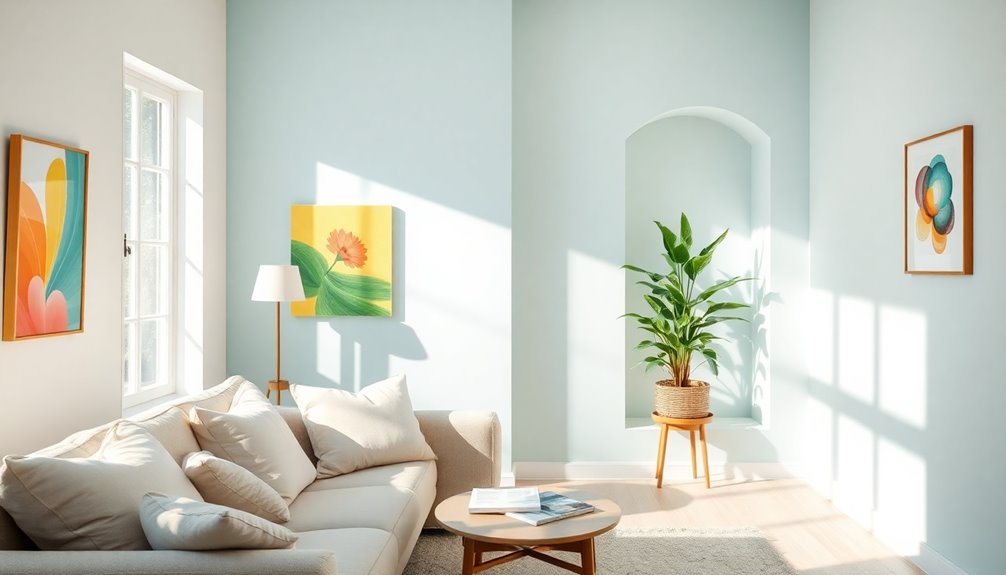
When you choose the right colors for your home, you can significantly impact your mental well-being. Calming colors like blue and green create a tranquil environment, lowering blood pressure and reducing anxiety. Incorporating these hues can enhance relaxation, making your space a peaceful retreat. Additionally, using calming colors in therapy settings has been shown to foster tranquility and reduce anxiety. Research indicates that positive thinking can also be reinforced in environments utilizing these soothing colors.
On the other hand, warm colors such as red, orange, and yellow stimulate energy and happiness, perfect for lively areas like kitchens or dining rooms. However, be mindful not to overuse them, as they can lead to stress.
Ultimately, understanding your emotional responses to colors enables you to craft a home that not only looks good but also supports your mental health, promoting a balanced and uplifting atmosphere.
Practical Uses of Color
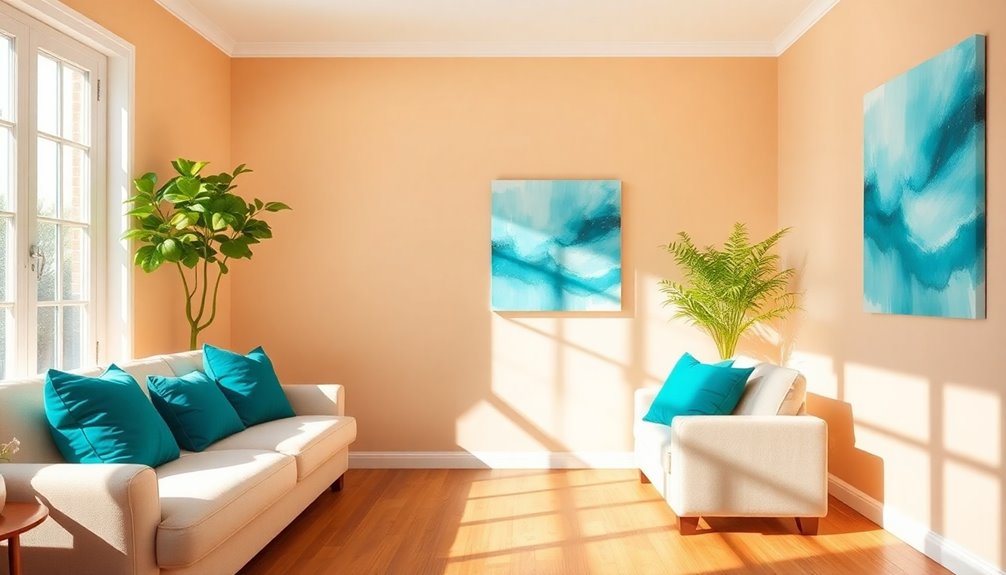
Color plays a crucial role in shaping the atmosphere of your home, influencing everything from mood to productivity.
If you want to boost focus in your workspace, consider painting your walls blue. For creativity, yellow is perfect in your home office or studio. Green enhances balance and reduces eye strain, making it ideal for work areas. Understanding color psychology can further enhance your color choices for specific emotional outcomes. Additionally, colors can impact your financial decisions, similar to how indexed annuities provide a balance between risk and reward.
If you're looking for energy, orange can motivate you in high-activity spaces. Red increases alertness, great for kitchens or dining rooms.
Warm colors like red, orange, and yellow evoke happiness, while cool colors like blue and green create calmness.
Creating Your Ideal Environment
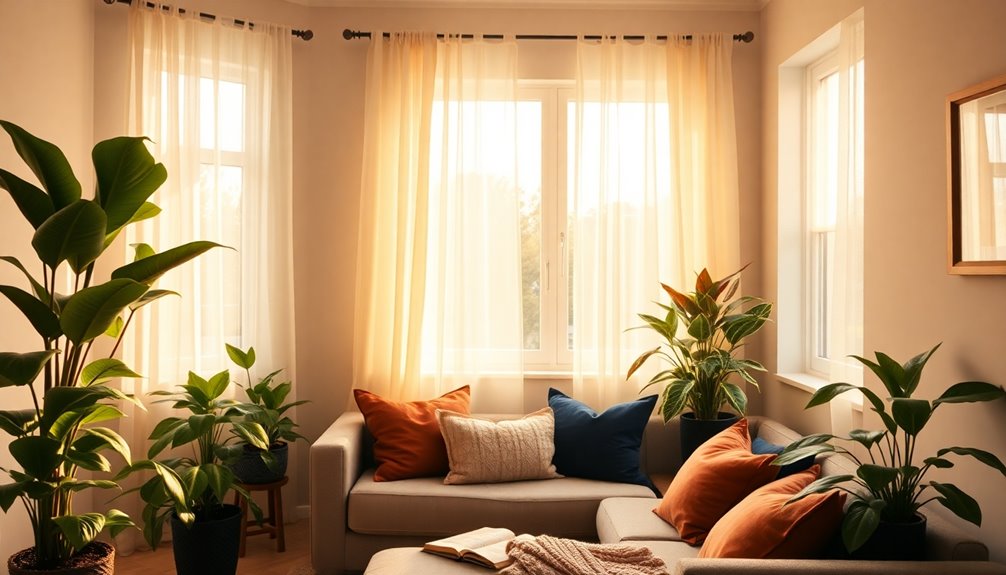
Selecting the right colors for your home isn't just about aesthetics; it's about creating an environment that resonates with your needs and emotions. Understanding color psychology can help you choose hues that enhance your mood and reflect your personality.
For instance, vibrant colors like red and yellow energize spaces like the kitchen and living room, promoting social interaction. In contrast, calming shades like blue and green are perfect for bedrooms and bathrooms, fostering relaxation and peace. Additionally, incorporating warm colors can create an energetic and welcoming atmosphere in communal areas, while calming color schemes can enhance tranquility in your bathroom sanctuary.
Balance is key; pair bold colors with neutrals to maintain harmony. Ultimately, personalize your space with colors that make you feel comfortable and inspired, turning your home into a true reflection of who you are.
Experiment and enjoy the process!
Frequently Asked Questions
How Do I Choose Colors Based on My Personality?
To choose colors based on your personality, start by identifying which colors resonate with you emotionally.
If you're energetic and passionate, warm colors like red or orange might suit you. If you prefer calmness, consider cool colors like blue or green.
Reflect on how different shades make you feel—do they inspire creativity or relaxation?
Balance your choices with neutrals to enhance your space and ensure it reflects your true self.
Trust your instincts!
Can Color Preferences Change Over Time?
Yes, color preferences can definitely change over time.
Factors like hormonal changes, seasonal shifts, and personal experiences influence your choices. As you age, you might find yourself gravitating towards more muted tones.
Your mood and emotions also play a role; during stressful times, you may prefer calm colors.
Plus, social and cultural influences can shape your preferences, making them evolve as you navigate different environments and life stages.
What Are the Cultural Meanings of Specific Colors?
Colors whisper stories of cultures, each hue a brushstroke on the canvas of human experience.
When you think of red, it ignites passion in Western cultures, while in Asia, it dances with luck and joy.
Blue wraps you in calmness and trust, though it may carry sadness too.
Meanwhile, yellow radiates warmth and happiness in the West, yet in Eastern cultures, it echoes courage and prosperity.
Discover these meanings, and let them inspire your choices.
How Does Lighting Affect Color Perception in a Room?
Lighting dramatically affects how you perceive color in a room.
Natural light can cast cool or warm tints based on the time of day, altering color saturation and consistency. Rooms with northern exposure benefit from steady light, while eastern and western rooms enjoy changing warmth.
Artificial light types, like fluorescent and LED, also influence color appearance.
Understanding these effects helps you choose the right colors, making your space feel just right.
Are There Color Combinations to Avoid for Small Spaces?
Yes, there are color combinations to avoid in small spaces. You should steer clear of too many bright colors, as they can overwhelm the area.
Clashing complementary colors, like red and green, also create chaos. Remember to balance bold hues with neutral tones to maintain harmony.
Additionally, avoid using colors with insufficient contrast, as they can make your space feel dull and uninviting. Keep your color scheme cohesive to create a welcoming atmosphere.
Conclusion
Incorporating color psychology into your home is like painting a canvas of emotions. By understanding how colors influence your feelings and choosing the right shades for each space, you can create an environment that nurtures your mental well-being. Whether you want a calming oasis or an energizing workspace, the right colors can transform your home into a reflection of your ideal self. So grab your palette and start crafting the perfect atmosphere that truly feels like home.



